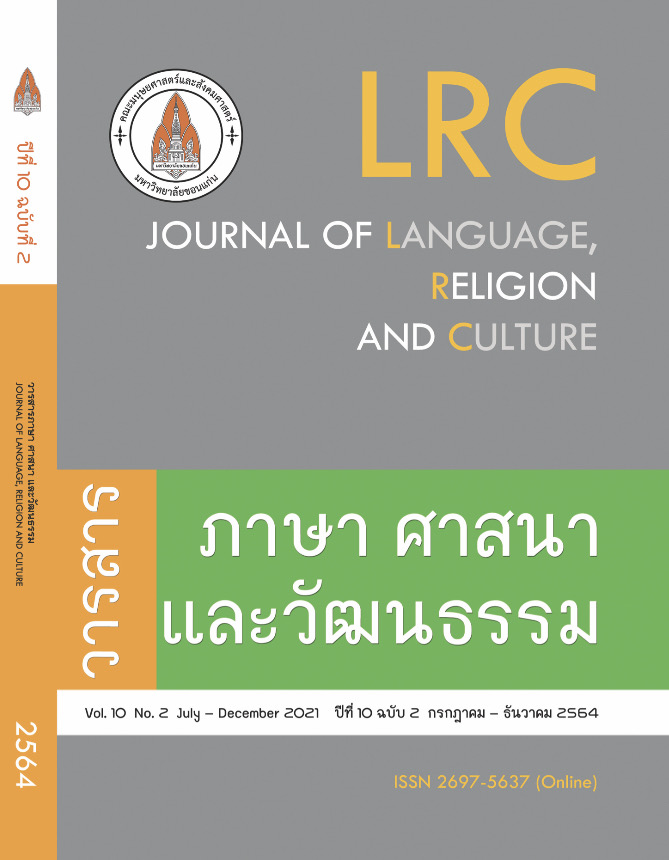การศึกษาการใช้คำปรากฏร่วมของนักศึกษาสาขาวิชาภาษาญี่ปุ่นในภาคใต้
การศึกษาการใช้คำปรากฏร่วมของนักศึกษาสาขาวิชาภาษาญี่ปุ่นในภาคใต้
คำสำคัญ:
คำปรากฏร่วม, คลังข้อมูลภาษา, นักศึกษาสาขาวิชาภาษาญี่ปุ่น, คำกริยาหลายความหมายบทคัดย่อ
งานวิจัยชิ้นนี้มีวัตถุประสงค์ เพื่อศึกษาการใช้คำปรากฏร่วมรวมถึงปัญหาการใช้คำปรากฏร่วมของนักศึกษาสาขาวิชาภาษาญี่ปุ่นในภาคใต้ กลุ่มตัวอย่าง ได้แก่ นักศึกษาสาขาวิชาภาษาญี่ปุ่นที่กำลังศึกษาในมหาวิทยาลัยสงขลานครินทร์ วิทยาเขตปัตตานีและมหาวิทยาลัยทักษิณ จังหวัดสงขลา ชั้นปีที่ 3-5 จำนวน 108 คน เครื่องมือที่ใช้ในการวิจัย คือ แบบทดสอบการใช้คำปรากฏร่วมในรูปแบบของคำนามกับคำกริยา(คำนาม+を+คำกริยา)ที่คัดเลือกมาจากตำราเรียน Minna no Nihongo และ Genki
ผลการศึกษา พบว่า 1) กรณีให้เขียนคำกริยาที่ปรากฏร่วมกับคำนาม ข้อคำถามที่กลุ่มตัวอย่างตอบถูกมากกว่าร้อยละ 80 ได้แก่「薬を飲む」(กินยา)「シャワーを浴びる」( อาบน้ำ) 「歌を歌う」(ร้องเพลง) และ「写真を撮る」 (ถ่ายรูป) 2) กรณีให้เลือกตอบคำกริยาจากตัวเลือกที่กำหนดให้ ข้อคำถามที่กลุ่มตัวอย่างเลือกตอบถูกมากกว่าร้อยละ 80 ได้แก่「 着物を着る」(สวมกิโมโน) และ「夢を見る」(ฝัน)「絵を描く」(วาดภาพ)「 帽子をかぶる」(สวมหมวก) และ 3) กรณีให้เลือกเติมคำกริยาหลายความหมายที่ปรากฏคู่กับคำนามที่กำหนดให้ ข้อคำถามที่กลุ่มตัวอย่างเลือกตอบถูกมากกว่าร้อยละ 80 ได้แก่「スポーツをする 」(เล่นกีฬา)「デートをする」(ออกเดท) และ「買い物をする」 (ซื้อของ)「ギターをひく」(เล่น/ดีดกีตาร์)「エアコンをつける」(เปิดแอร์)
ส่วนปัญหาการใช้คำปรากฏร่วมของกลุ่มตัวอย่าง ได้แก่ 1) ปัญหาการใช้คำปรากฏร่วมกรณีต้องเลือกคำกริยาที่มีหลายความหมาย เช่น「ひく」「する」「つく」2) ปัญหาการใช้คำปรากฏร่วมที่มีความหมายใกล้เคียงภาษาไทย เช่น「ごみを出す」กับ「ごみを捨てる」(ทิ้งขยะ) และ「熱を出す」กับ「熱がある」(เป็นไข้/มีไข้) 3) ปัญหาการใช้คำปรากฏร่วมที่กลุ่มตัวอย่างไม่มั่นใจในการเลือกใช้คำกริยา เช่น「パーマをかける 」กับ「パーマをする 」(ดัดผม) และ「コピーをとる」กับ「コピーをする 」(ถ่ายเอกสาร)
นอกจากนี้ ผู้วิจัยได้เสนอแนวทางการสอนคำปรากฏร่วมภาษาญี่ปุ่นเพื่อนำไปประยุกต์ใช้ในการเรียนการสอนภาษาญี่ปุ่นแก่ผู้เรียนชาวไทยต่อไป
เอกสารอ้างอิง
ณัฏฐิรา ทับทิม. (2562). การปรากฏร่วมกันของคำในภาษาญี่ปุ่น: กรณีศึกษาคำนามจากคลังข้อมูลภาษา.วารสารเครือข่ายญี่ปุ่นศึกษา, 9(1), 49-68.
เนาวรัตน์ อินทรประสิทธิ์. (2556). การศึกษาการปรากฏของคำปรากฏร่วมในหนังสือนวนิยายภาษาอังกฤษ, บทความวิจัยรายงานการประชุมวิชาการระดับชาติ มหาวิทยาลัยเทคโนโลยีราช มงคลตะวันออกครั้งที่ 6, 1110-1116.
บุศรินทร์ เดชดำรงปรีชา. (2555). การรับรู้การใช้คำปรากฏในภาษาอังกฤษของผู้เรียนไทย. วารสารวิจัย มสด (สาขามนุษยศาสตร์และสังคมศาสตร์ มหาวิทยาลัยสวนดุสิต), 37-53.
ปรีมา มัลลิกะมาส,สมจิต จิระนันทิพร,และรักสงบ วิจิตรโสภณ. (2557). การศึกษาเปรียบต่างการใช้คำปรากฏร่วมภาษาอังกฤษของผู้เรียนชาวไทยและเจ้าของภาษาโดยใช้คลังข้อมูล.วารสารอักษรศาสตร์,43(1), 95-157.
ปรีมา มัลลิกะมาส. (2546). บทบาทของคำปรากฏร่วมในการพัฒนาทักษะการใช้ภาษาอังกฤษ. วารสารภาษาปริทัศน์, 20, 62-76.
มินนะ โนะ นิฮงโกะ 1-4 [2nd Edition] (2549). แบบเรียนภาษาญี่ปุ่นระดับต้น (ฉบับปรับปรุง)กรุงเทพฯ : สํานักพิมพ์ภาษาและวัฒนธรรม.
วิษณุ หาญศึก.(2563). ลักษณะและโครงสร้างของคำปรากฏร่วมภาษาญี่ปุ่น วารสารวิชาการ มหาวิทยาลัยราชภัฏพระนคร, 11(2), 366-380.
Akimoto Miharu.(1993). On the Significance of Collocations in Vocabulary and Language Teaching.Proceedings of the 4th conference on second language research in
Japan, 28-51. (in Japanese)
Backhouse, A.E. (2006). Collocations as units for vocabulary acquisition. Journal of the International Student Center, Hokkaido University, 10, 125-134. (in Japanese)
Banno Eri. (2011). Genki 1-2 [2nd Edition]. The Japan Time.
Fang Xiao-yun.(2016). Dai ni gengo to shite no nihongo rengo shūtoku ni tsuite. Center for
Multicultural Public Sphere (CMPS),Departmental Bulletin Paper,Faculty of International Studies Utsunomiya University, 8, 112-119. (in Japanese)
Ishikawa Yasuko.(2013). Gaikokujin nihongo gakushū no Bunpō teki yosoku ryoku o dō sodateru
Ka-shokyū dankai no gakushūsha ni mukete-The Japan Foundation,Bangkok Japanese Language Education Bulletin ,10 ,1-14. (in Japanese)
Konta Kenzo.(2013). The List of Collocations Effective for Communication : To Improve the Way of Teaching Collocations by Using the Learner's Corpus.Language and culture,
bulletin of the Graduate Course, Kanagawa University, 9, 157- 196. (in Japanese)
Lee Wenping. (2014). Collocation Research Based on Corpora Collected from Japanese Textbooks in China and Japanese Native Speakers. Journal of Japanese – Language Education, 157, 63-77. (in Japanese)
Miyoshi Yūko.(2007). An experimental study of the effects of teaching words in Collocations.
Journal of Japanese Language Teaching, 134, 80-89. (in Japanese)
Nakamata Naoki.(2014 ). Grammatical Collocation Handbook for Japanese education. Tokyo:
Kurosio Publishers. (in Japanese)
Nakamizo Tomoko,Sakai Mieko,Kanamori Yumi & ōiwa Koutarou. (2011). Similarities and
differences between collocations using the Kango Nouns "Shinpo" and "Kōjō". Journal of Higher Education Yamaguchi University, 8, 88-95. (in Japanese)
Noda Hisashi.(2007).Bunpō teki na korokēshon to imi teki na korokēshon.Nihongogaku, 26,18-27.
Qu Xiaoyan.(2010). Tango no imi suisoku to rengo shidō no kōka -chūgoku daigaku nihongo senkō katei no sōgō nihongo jugyō ni okeru jissen-Nihongengo bunka kenkyū Kai ronshū, 6, 265-292. (in Japanese)
Strafella, E.L. & Kikuo Maekawa.(2015). Japanese-language Education and Collocations: The
Importance of Learning Word Co-occurrences.JCL Workshop papers, National Institute for Japanese Language and Linguistics, 7, 73-78. (in Japanese)
Suzuki Ayano.(2014). A study of collocation acquisition in learners of Japanese,with a focus on the verb “suru” (Doctoral Dissertation).Tokyo University of Foreign Studies. (in Japanese)
Tanomura Tadaharu.(2009). Retrieving collocational information from Japanese corpora: an
attempt towards the creation of a dictionary of collocations. Osaka University Knowledge Archive, 21, 21-41. (in Japanese)
Tanomura Tadaharu.(2010). Japanese corpora and their lexicographic applications with, special emphasis on collocation. Journal of the Linguistic Society of Japan,1-23. (in Japanese)







